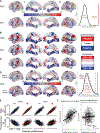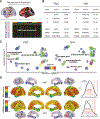Normative brain size variation and brain shape diversity in humans
- PMID: 29853553
- PMCID: PMC7485526
- DOI: 10.1126/science.aar2578
Normative brain size variation and brain shape diversity in humans
Abstract
Brain size variation over primate evolution and human development is associated with shifts in the proportions of different brain regions. Individual brain size can vary almost twofold among typically developing humans, but the consequences of this for brain organization remain poorly understood. Using in vivo neuroimaging data from more than 3000 individuals, we find that larger human brains show greater areal expansion in distributed frontoparietal cortical networks and related subcortical regions than in limbic, sensory, and motor systems. This areal redistribution recapitulates cortical remodeling across evolution, manifests by early childhood in humans, and is linked to multiple markers of heightened metabolic cost and neuronal connectivity. Thus, human brain shape is systematically coupled to naturally occurring variations in brain size through a scaling map that integrates spatiotemporally diverse aspects of neurobiology.
Copyright © 2018 The Authors, some rights reserved; exclusive licensee American Association for the Advancement of Science. No claim to original U.S. Government Works.
Figures



Comment in
-
Scaling of human brain size.Science. 2018 Jun 15;360(6394):1184-1185. doi: 10.1126/science.aat8948. Science. 2018. PMID: 29903961 No abstract available.
References
-
- Ad-Dab’bagh Y. et al., The CIVET image-processing environment: A fully automated comprehensive pipeline for anatomical neuroimaging research. Proceedings of the 12th Annual Meeting of the Organization for Human Brain Mapping (2006).
Publication types
MeSH terms
Grants and funding
LinkOut - more resources
Full Text Sources
Other Literature Sources

